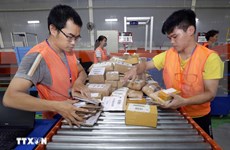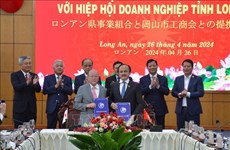Development directions for southeastern region, Mekong Delta outlined
The Ministry of Planning and Investment (MPI) held a teleconference on August 31 to look into orientations for making plans on socio-economic development and public investment in the southeastern and Mekong Delta regions in the next few years.
 A view of Long Xuyen city, the Mekong Delta province of An Giang (Photo: VNA)
A view of Long Xuyen city, the Mekong Delta province of An Giang (Photo: VNA)Hanoi (VNA) – The Ministry of Planning and Investment (MPI) held a teleconference on August 31 to look into orientations for making plans on socio-economic development and public investment in the southeastern and Mekong Delta regions in the next few years.
Addressing the conference, which was attended by officials from 19 provinces and cities in the two regions, Minister Nguyen Chi Dung said the plans for 2021 and the 2021-2025 period need to be consistent with and bring into play the achievements obtained during 2016-2020 while devising development strategies, plans and solutions that can tap into local potential and advantages, thereby making breakthroughs and stronger development in the new period.
Development directions must centre on the people by paying attention to ensuring social security and sustainably reducing poverty, especially in ethnic minority communities and remote, border and insular areas, so as to narrow the development gap among regions, he noted.
According to the minister, the southeastern region has to particularly prioritise mobilising resources for developing seaports, airports and roads linking local ports. Cargo transportation should also be coordinated rationally to optimise local seaports, including Cat Lai and Cai Mep-Thi Vai.
Meanwhile, localities in the Mekong Delta should pay heed to solving problems related to transport, water storage reservoirs and riverbank and coastal erosion, Dung said, adding that transport corridors should be developed into economic ones so as to expand the space for development.
The MPI expected that between 2021 and 2025, southeastern provinces and cities will garner the best possible conditions for developing the economy and making use of the switch of global investment flows, attract large-scale and hi-tech investment to form value chains, strongly develop services, and step up administrative reforms and investment business improvement.
Global supply chains will soon be formed in this region, which will become a technological and manufacturing hub of Vietnam. Ho Chi Minh City’s role as an economic locomotive will also be upheld so that the region will remain a growth driving force of the country in the time ahead.
For 2021-2025, Mekong Delta provinces and cities are set to strive to reach a higher development level, per capita income surpassing the national average, and eco-agriculture and hi-tech farming making up a bigger proportion in the local economy.
Besides, diverse resources will be used efficiently to turn the Mekong Delta into a prosperous region adapted to climate change. Transport infrastructure will be expanded to connect localities in the region and link the Mekong Delta with HCM City and the southeastern region, the MPI added./.












